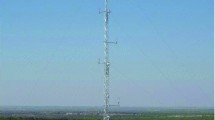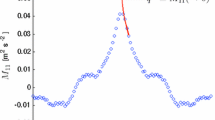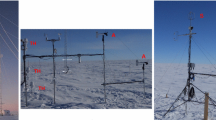Abstract
Data from a 32-m tower located near Ocotillo, Texas (\(32.12050^{\circ }\)N; \(101.37555^{\circ }\)W), provide an opportunity to examine the relevance of standard micrometeorological flux–gradient formulations to observations made in an area characteristic of a large portion of the central USA, within the Southern Great Plains. Comparison with data obtained at a greater height (80 m) reveals that the velocity distributions change substantially between the lower set of observations and the upper, with the former being constrained at the low wind-speed end. In the early morning, sensible heat-flux divergence correlates well with the measured rate of change of temperature with time within the surface layer of air sampled by the tower, but this association disappears when the depth of the mixed layer extends beyond the reach of the tower. As in the case of all previous examinations of flux–gradient relationships, the overall dependence of the dimensionless wind and temperature gradients \(\phi _\mathrm{m}\) and \(\phi _\mathrm{H}\) on stability is characterized by considerable scatter, with the familiar relationships best describing the average. For conditions of stable stratification, there is indeed the expected close proximity of \(\phi _\mathrm{m}\) and \(\phi _\mathrm{H}\), however, describing either \(\phi _\mathrm{m}\) or \(\phi _\mathrm{H}\) in terms of the classical stability index \(Z/L\) (where \(Z\) is the height above the zero plane and L is the Obukhov length scale of turbulence) then appears questionable because the dependence of \(\phi _\mathrm{m}\) on the measured sensible heat flux is not always single-valued, especially near the surface. For unstable stratification, support is found for the conclusions of early workers that free convection initiates at about \(Z/L \approx -0.03\), and that the general behaviour is then compatible with the concept of a moving air mass from which momentum is continuously extracted, embedded within freely convective cells. It is concluded that legacy descriptions of the relationships between fluxes and gradients apply to averages that might occur rarely, that a dominant factor is likely the chaotic nature of the processes that control the variables considered in these relationships, and that the net consequence of the original randomness is that the levels of predictability theoretically attainable might never be realized in practice.











Similar content being viewed by others
References
Baas P, Steeneveld GJ, van de Wiel BJH, Holtslag AAM (2006) Exploring self-correlation in flux–gradient relationships for stably stratified conditions. J Atmos Sci 63:3045–3054
Brooks FA (1961) Need for measuring horizontal gradients in determining vertical eddy transfers of heat and moisture. J Meteorol 18:589–596
Businger JA (1988) A note on the Businger–Dyer profiles. Boundary-Layer Meteorol 42:145–151
Businger JA, Wyngaard JC, Izumi Y, Bradley EF (1971) Flux profile relationships in the atmospheric surface layer. J Atmos Sci 28:181–189
Dyer AJ (1974) A review of flux–profile relationships. Boundary-Layer Meteorol 7:363–372
Dyer AJ, Hicks BB (1970) Flux–gradient relationships in the constant flux layer. Q J R Meteorol Soc 96:715–721
Garratt JR (1992) The atmospheric boundary layer. Cambridge University Press, UK, 316 pp
Garratt JR, Hicks BB (1973) Momentum, heat and water vapour transfer to and from natural and artificial surfaces. Q J R Meteorol Soc 99:680–687
Hicks BB (1978) Some limitations of dimensional analysis and power laws. Boundary-Layer Meteorol 14:1451–1458
Hicks BB (1981) An examination of turbulence statistics in the surface boundary layer. Boundary-Layer Meteorol 21:389–402
Klipp CL, Mahrt L (2004) Flux–gradient relationship, self-correlation and intermittency in the stable boundary layer. Q J R Meteorol Soc 130:2087–2103
Kochendorfer J, Meyers TP, Frank J, Massman WJ, Heuer MW (2012) How well can we measure the vertical wind speed? Implications for fluxes of energy and mass. Boundary-Layer Meteorol 145:383–398
Mahrt L (2010) Variability and maintenance of turbulence in the very stable boundary layer. Boundary-Layer Meteorol 135:1–18
Monin AS, Obukhov AM (1954) Basic relationships of turbulent mixing in the surface layer of the atmosphere. Acad Nauk SSSR Trud Geofys Inst 24:163–187
Panofsky HA, Blackadar AK, McVehil GE (1960) The diabatic wind profile. Q J R Meteorol Soc 86:390–398
Plate EJ (1971) Aerodynamic characteristics of atmospheric boundary layers. US Atomic Energy Commission, Springfield, VA, TID-25465, 190 pp
Priestley CHB (1955) Free and forced convection in the atmosphere near the ground. Q J R Meteorol Soc 81:139–143
Priestley CHB (1959) Turbulent transfer in the lower atmosphere. University of Chicago Press, Chicago, 130 pp
Webb EK (1965) Aerial microclimate. Meteorol Monogr 6:27–58
White R, Vogel CA, Pendergrass WR (2014) Flux Observations Ocotillo Texas (FOOT) Experiment. NOAA Atmospheric Turbulence and Diffusion Division Technical Memorandum (in press)
Whiteman CD, Bian X, Zhong S (1997) Low-level jet climatology from enhanced rawinsonde observations at a site in the southern Great Plains. J Appl Meteorol 36:1363–1376
Acknowledgments
Mention of specific instrumentation does not constitute an endorsement; other systems could work as well if not better. The data used here were collected as a part of an investigation of the planetary boundary layer in support of the wind energy program of Duke Power, Inc. As part of the NOAA/Duke Cooperative Research and Development Agreement, NOAA/ARL/ATDD and Duke Energy established a research station at Duke’s West Texas Ocotillo Wind Farm. The collaboration is with the Air Resources Laboratory of NOAA.
Author information
Authors and Affiliations
Corresponding author
Rights and permissions
About this article
Cite this article
Hicks, B.B., Pendergrass, W.R., Vogel, C.A. et al. On the Micrometeorology of the Southern Great Plains 1: Legacy Relationships Revisited. Boundary-Layer Meteorol 151, 389–405 (2014). https://doi.org/10.1007/s10546-013-9902-2
Received:
Accepted:
Published:
Issue Date:
DOI: https://doi.org/10.1007/s10546-013-9902-2




